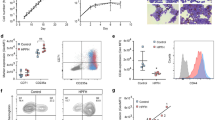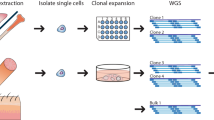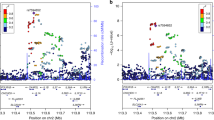Abstract
The Changes in the type of haemoglobin (Hb) produced during embryonic, fetal and adult life, have served as a paradigm for understanding the developmental regulation of human genes. A genetically determined persistence of fetal Hb synthesis has an ameliorating effect on β thalassaemia and sickle cell anaemia, globally the commonest single gene disorders. The search for the putative gene(s) controlling the level of fetal Hb production has been extremely difficult because this trait may be influenced by several factors. We have studied a large kindred with hereditary persistence of fetal haemoglobin (HPFH). Using a genetic mapping strategy and statistical methods that account simultaneously for the effects of several genetic factors, we have demonstrated that in addition to the two factors (β thalassaemia and Xmn l-Gγ site) on chromosome 11 p, there is a third major genetic determinant for fetal Hb production localized on chromosome 6q.
This is a preview of subscription content, access via your institution
Access options
Subscribe to this journal
Receive 12 print issues and online access
$209.00 per year
only $17.42 per issue
Buy this article
- Purchase on Springer Link
- Instant access to full article PDF
Prices may be subject to local taxes which are calculated during checkout
Similar content being viewed by others
References
Stamatoyannopoulos, G. & Nienhuis, A.W. Hemoglobin switching. in The molecular basis of blood diseases (2nd Edition) (eds Stamatoyannopoulos, G., Nienhuis, A.W., Majerus, P.W. & Varmus, H.) 107–155 (W.B. Saunders and Co., Philadelphia, 1994).
Grosveld, F., van Assendelft, G.B., Breaves, D.R. & Kollias, G. Position-independent, high-level expression of the human γ-globin gene in transgenic mice. Cell 51, 975–985 (1987).
Sampietro, M., Thein, S.L., Contreras, M. & Pazmany, L. Variation of HPF and F-cell number with the G-γXmn I (C-T) polymorphism in normal individuals. Blood 79, 832–833 (1992).
Zago, M.A. et al. Genetic control of F cells in human adults. Blood 53, 977–986 (1979).
Miyoshi, K. et al. X-linked dominant control of F-cells in normal adult life: Characterization of the Swiss type as hereditary persistence of fetal hemoglobin regulated dominantly by gene(s) on X chromosome. Blood 72, 1854–1860 (1988).
Gianni, A.M. et al. A gene controlling fetal hemoglobin expression in adults is not linked to the non−a globin cluster. EMBO J. 2, 921–925 (1983).
Martinez, G., Novelletto, A., Di Rienzo, A., Felicetti, L. & Colombo, B. A case of hereditary persistence of fetal hemoglobin caused by a gene not linked to the β-globin cluster. Hum. Genet. 82, 335–337 (1989).
Thein, S.L. & Weatherall, D.J. A non-deletion hereditary persistance of fetal hemoglobin (HPFH) determinant not linked to the β-globin gene complex. in Hemoglobin Switching, Part B: Cellular and Molecular Mechanisms (eds Stamatoyannopoulos, G. & Nienhuis, A.W.) 97–111 (Alan R. Liss, Inc., New York, 1989).
Giampaolo, A. et al. Heterocellular HPFH: molecular mechanisms of abnormal γ gene expression in association with β-thalassemia and linkage relationship with the β-globin gene cluster. Hum. Genet. 66, 151–156 (1984).
Dover, G.J. et al. Fetal hemoglobin levels in sickle cell disease and normal individuals are partially controlled by an X−linked gene located at Xp22.2. Blood 80, 816–824 (1992).
Chang, Y.C., Smith, K.D., Moore, R.D., Serjeant, G.R. & Dover, G.J. An analysis of fetal hemoglobin variation in sickle cell disease: the relative contributions of the X-linked factor, β-globin haplotypes, α-globin gene number, gender and age. Blood 85, 1111–1117 (1995).
Cappellini, M.D., Fiorelli, G. & Berini, L.F. Interaction between homozygous β° thalassaemia and the Swiss type of hereditary persistence of fetal haemoglobin. Br. J. Haem. 48, 561–572 (1981).
Perrine, S.P., Brown, M.J., Clegg, J.B., Weatherall, D.J. & May, A. Benign sickle-cell anaemia. Lancet 2, 1163 (1972).
Rutland, P.C., Pembrey, M.E. & Davies, T. The estimation of fetal haemoglobin in healthy adults by radioimmunoassay. Br. J. Haem. 53, 673–682 (1983).
Stamatoyannopoulos, G., Wood, W.G. & Papayannopoulou, T. A new form of hereditary persistence of fetal hemoglobin in blacks and its association with sickle cell trait. Blood 46, 683–692 (1975).
Rochette, J., Dode, C., Leturcq, F. & Krishnamoorthy, R. Level and composition of fetal hemoglobin expression in normal newborn babies are not dependent on β cluster DNA haplotype. Am. J. Hem. 34, 223–224 (1990).
Gilman, J.G. & Huisman, T.H.J. DNA sequence variation associated with elevated fetal Gγ globin production. Blood 66, 783–787 (1985).
Bonney, G.E. On the statistical determination of major gene mechanisms in continuous human traits: regressive models. Am. J. Med. Genet. 18, 731–749 (1984).
Bonney, G.E., Lathrop, G.M. & Lalouel, J.-M. Combined linkage and segregation analysis using regressive models. Am. J. Hum. Genet. 43, 29–37 (1988).
Thein, S.L. et al. Detection of a major gene for heterocellular hereditary persistence of fetal hemoglobin after accounting for genetic modifiers. Am. J. Hum. Genet. 54, 214–228 (1994).
Demenais, F.M., Murigande, C. & Bonney, G.E. Search for faster methods of fitting the regressive models to quantitative traits. Genet. Epidemiol. 7, 319–334 (1990).
Weissenbach, J. et al. A second-generation linkage map of the human genome. Nature. 359, 794–801 (1992).
Gyapay, G. et al. The 1993–94 Généthon human genetic linkage map. Nature Genetics 7, 246–339 (1994).
Morton, I.N. The detection and estimation of linkage between the genes for elliptocytes and Rh phenotype. Am. J. Hum. Genet. 8, 80–96 (1956).
Ott, J. Analysis of Human Genetic Linkage (Johns Hopkins University Press, Baltimore, 1991).
Lander, E.S. & Schork, N.J. Genetic dissection of complex traits. Science 265, 2037–2048 (1994).
Hashimoto, L. et al. Genetic mapping of a susceptibility locus for insulin-dependent diabetes mellitus on chromosome 11q. Nature 371, 161–164 (1994).
Davies, J.L. et al. A genome-wide search for human type 1 diabetes susceptibility genes. Nature 371, 130–136 (1994).
Marsh, D.G. et al. Linkage analysis of IL4 and other chromosomes 5q31.1 markers and total serum immunoglobulin E concentrations. Science 264, 1152–1156 (1994).
Suarez, B.K., Hampe, C.L. & Van Eerdewegh, P. in Genetic Approaches to Mental Disorders (eds Gershon, E.S. & Cloninger, C.R.) 23–46 (American Psychiatric Press, Washington DC, 1994).
Martinez, M., Abel, L. & Demenais, F. How can maximum likelihood methods reveal candidate genes in a quantitative trait? Genet. Epidemiol. (in the press).
Crossley, M. & Orkin, S.H. Regulation of the β-globin locus. Curr. Opin. Genet. Devel. 3, 232–237 (1993).
Grosveld, F, Dillon, N. & Higgs, D. The regulation of human globin gene expression. in Baillière's Clinical Haematology (eds Higgs, D.R. & Weatherall, D.J.) 31–55 (BaillièreTindall, London, 1993).
Collins, F.S. Positional cloning: Let's not call it reverse anymore. Nature Genet. 1, 3–6 (1992).
DeSimone, J., Heller, R., Biel, M. & Zwiers, D. Genetic relationship between fetal Hb levels in normal and erythropoietically stressed baboons. Br. J. Haem. 49, 175–183 (1981).
Volz, A. et al. Report of the Second International Workshop on Human Chromosome 6. Genomics 21, 464–472 (1994).
Sparkes, R.S. et al. The gene for human liver arginase (ARG1) is assigned to chromosome band 6q23. Am. J. hum. Genet. 39, 186–193 (1986).
Meloni, R., Fougerousse, F., Roudaut, C. & Beckmann, J.S. Dinucleotide repeat polymorphism at the human liver arginase gene (ARG1). Nucl. Acids Res. 20, 1166 (1993).
Higgs, D.R. α-thalassaemia. in Baillière's Clinical Haematology. International Practice and Research: The Haemogtobinopathies (eds Higgs, D.R. & Weatherall, DJ.) 117–150 (Baillière Tindall, London, 1993).
Gibbons, R.J., Picketts, D.J., Vlllard, L. & Higgs, D.R X-linked mental retardation associated with α thalassaemia (ATR-X syndrome) results from mutations in a putative global transcriptional regulator. Cell 80, 837–845 (1995).
Thein, S.L., Wood, W.G., Wickramasinghe, S.N. & Galvin, M.C., Galvin, M.C. β-thalassemia unlinked to the β-globin gene in an English family. Blood 82, 961–967 (1993).
Lathrop, G.M., Lalouel, J.M., Julier, C. & Ott, J. Multilocus linkage analysis in humans: detection of linkage and estimation of recombination. Am. J. Hum. Genet. 37, 482–498 (1985).
Elston, R.C. & Stewart, J. A general model for the genetic anlaysis of pedigree data. Hum. Hered. 21, 523–542 (1971).
Demenais, F. & Lathrop, G.M. REGRESS: A computer program including the regression approach into the linkage package. Genet. Epidemiol. 11, 291 (1994).
Author information
Authors and Affiliations
Rights and permissions
About this article
Cite this article
Craig, J., Rochette, J., Fisher, C. et al. Dissecting the loci controlling fetal haemoglobin production on chromosomes 11p and 6q by the regressive approach. Nat Genet 12, 58–64 (1996). https://doi.org/10.1038/ng0196-58
Received:
Accepted:
Issue Date:
DOI: https://doi.org/10.1038/ng0196-58
This article is cited by
-
Mild dyserythropoiesis and β-like globin gene expression imbalance due to the loss of histone chaperone ASF1B
Human Genomics (2020)
-
Functional polymorphisms of BCL11A and HBS1L-MYB genes affect both fetal hemoglobin level and clinical outcomes in a cohort of children with sickle cell anemia
Annals of Hematology (2020)
-
Fetal Hemoglobin in Tunisian Sickle Cell Disease Patient: Relationship with Polymorphic Sequences Cis to the β-Globin Gene
Indian Journal of Hematology and Blood Transfusion (2016)
-
Contribution of β-globin cluster polymorphisms to raise fetal hemoglobin levels in normal adults
Molecular Biology Reports (2012)
-
Family-based designs for genome-wide association studies
Nature Reviews Genetics (2011)



